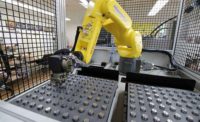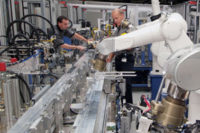Manufacturing had a great year in 2018, and 2019 promises to be as good. However, clouds are on the horizon.
For one, U.S. manufacturers are facing the worst labor shortage in 20 years. In June 2018, the Federal Reserve Bank of St. Louis reported that job openings in manufacturing had reached 482,000 nationally, a 17-year high. At the same time, productivity growth in manufacturing has slowed. From 1992 to 2004, productivity increased by an average of 2 percent annually, according to the Bureau of Labor Statistics. In contrast, from 2004 through 2016, productivity declined by an average of 0.3 percent per year.
Increasing trade barriers are creating headwinds for exports of manufactured goods. And, though China has lost some of its manufacturing cost advantage recently, the country is investing aggressively to regain it. Chinese manufacturers installed 140,000 new robots in 2017. That’s 60 percent more than they purchased in 2016, and it’s a third of all robots produced worldwide in 2017.
The solution to these problems, according to a new study by Boston Consulting Group (BCG) and Carnegie Mellon University, is for U.S. manufacturers to invest more in robotics and automation. The study identifies five manufacturing sectors that could particularly benefit from greater automation: aerospace, apparel, electronics, machine shops and motor vehicles. In 2016, these five sectors collectively represented 29 percent of U.S. manufacturing imports, 19 percent of U.S. manufacturing labor costs, and 36 percent of the country’s $650 billion trade imbalance in manufacturing. In addition, many workers in these sectors manually perform repeatable tasks that could be automated.
The study also identifies five tasks that could be improved through greater automation:
- Identification and tracking of parts and tools. The study found that workers spend a lot of time tracing or retrieving items on the shop floor.
- Supervision and training. Frontline supervisors represent the second largest category of labor costs for U.S. manufacturers. Many of their tasks—for example, ensuring that workers use safe techniques for heavy lifting—could be automated.
- Routing and connecting wiring. Wiring and harness assembly remain largely manual tasks.
- Precision handling and assembly of small parts. This is actually a strength of automation, but high-mix, low-volume production is thwarting attempts to automate.
- Translating schematics into production. Workers cite “reviewing blueprints” as one of their most frequent tasks during assembly and inspection.
If manufacturers are to automate these tasks, technological improvements will be needed. Robots will need better perception, sensing and situational awareness. They’ll also need greater dexterity and adaptability. The workforce will also need improvement. BCG estimates that half of today’s skilled workforce may not qualify for the jobs that will be in the greatest demand over the next decade.




